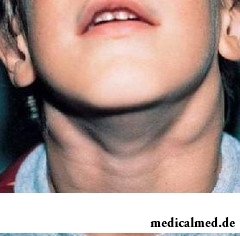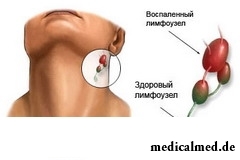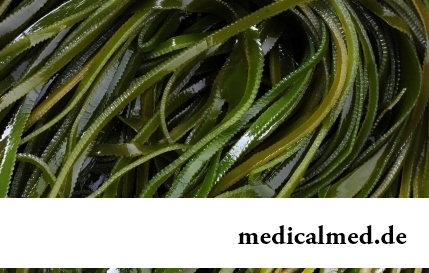





Submaxillary lymphadenitis
Submaxillary lymphadenitis is a widespread inflammatory pathology of lymph nodes. Such nodes  represent peripheral accumulations of an adenoid tissue. They perform protective function in an organism, becoming a peculiar barrier before an infection. On localization allocate lymphadenites of cervical, axillary, inguinal, submaxillary and other lymph nodes. Submaxillary lymphadenitis, as well as any lymphadenitis in general, can be purulent and not purulent, acute and chronic. Most often the inflammation is caused by streptococci, staphylococcus and their toxins which get into lymph nodes with a blood flow or a lymph from the inflammation center. Sometimes lymphadenitis can be caused by specific microorganisms – Koch's stick (the causative agent of tuberculosis), a pale treponema (the causative agent of syphilis). Lymphadenitis happens simple (hypostasis develops), hyperplastic (fabrics of a node increase in volume) and destructive (the node and surrounding fabrics collapses).
represent peripheral accumulations of an adenoid tissue. They perform protective function in an organism, becoming a peculiar barrier before an infection. On localization allocate lymphadenites of cervical, axillary, inguinal, submaxillary and other lymph nodes. Submaxillary lymphadenitis, as well as any lymphadenitis in general, can be purulent and not purulent, acute and chronic. Most often the inflammation is caused by streptococci, staphylococcus and their toxins which get into lymph nodes with a blood flow or a lymph from the inflammation center. Sometimes lymphadenitis can be caused by specific microorganisms – Koch's stick (the causative agent of tuberculosis), a pale treponema (the causative agent of syphilis). Lymphadenitis happens simple (hypostasis develops), hyperplastic (fabrics of a node increase in volume) and destructive (the node and surrounding fabrics collapses).
Reasons of submaxillary lymphadenitis
Most often infectious process in an oral cavity is the reason of submaxillary lymphadenitis. It can be tonsillitis, paratonsillar abscess, periodontosis, an ulitis, a periostitis, osteomyelitis upper or a mandible, multiple caries. In rare instances if the infection got into lymph nodes at their injury, submaxillary lymphadenitis can be primary disease.
Symptoms of submaxillary lymphadenitis
The first manifestation of an acute form of a disease is pain in the affected lymph nodes. At first pain can be only when pressing, and then becomes the constant pulsing, shooting, intensive, amplifying at the movement. Pain forces the patient to adopt the forced provision, prevents to sleep on the struck party, to talk, swallow of food. Sometimes pain does not allow to open a mouth. In the place of an inflammation the hyperemia (reddening) of integuments develops, hypostasis develops. After a while skin gets a cyanotic shade. To the touch it is possible to define the dense, increased in sizes, painful lymph node. Skin temperature over the affected lymph nodes is higher, than over the neighboring sites. Except local symptomatology, also the general develops. Body temperature increases (sometimes higher than 40 degrees). There are a fever, perspiration, weakness, a headache, sleeplessness. At a chronic form of a disease the pain syndrome is not so intensive, the increased lymph nodes are defined a long time, the general state suffers a little. Diagnosis of a disease in typical cases does not represent complexity for specialists. Only at heavy submaxillary lymphadenitis differential diagnosis with osteomyelitis, phlegmon can be necessary. At chronic submaxillary lymphadenitis for establishment of the diagnosis the puncture biopsy of a node is sometimes necessary.
Treatment of submaxillary lymphadenitis
Treatment of submaxillary lymphadenitis is carried out by the surgeon or the general practitioner. First of all sanitation of the center of an infection is carried out. Sometimes urgent intervention of the stomatologist (an odontectomy, opening of abscess of a jaw) is required. Submaxillary lymphadenitis is often treated conservatively. To the patient appoint rinsings by Burov's liquid, lotions, antibiotics, vitamins, physiotreatment (UVCh). If there is a purulent fusion of a lymph node, an operative measure is necessary. If the single lymph node is involved in process, the surgeon carries out a skin section over it, enters a drainage under the capsule, washes out a surgical wound. If several nodes are struck at once, opening of integuments in submaxillary area is carried out, the drainage in a fatty tissue is established to provide pus outflow. Antibiotics are surely appointed. Preference is given to drugs in an injection form (pricks). Usually the doctor chooses a modern antibiotic of a broad spectrum of activity taking into account sensitivity of microorganisms to it. If the specific nature (syphilis, tuberculosis) is established, treatment of submaxillary lymphadenitis is carried out by drugs according to the developed schemes.
of submaxillary lymphadenitis is carried out by the surgeon or the general practitioner. First of all sanitation of the center of an infection is carried out. Sometimes urgent intervention of the stomatologist (an odontectomy, opening of abscess of a jaw) is required. Submaxillary lymphadenitis is often treated conservatively. To the patient appoint rinsings by Burov's liquid, lotions, antibiotics, vitamins, physiotreatment (UVCh). If there is a purulent fusion of a lymph node, an operative measure is necessary. If the single lymph node is involved in process, the surgeon carries out a skin section over it, enters a drainage under the capsule, washes out a surgical wound. If several nodes are struck at once, opening of integuments in submaxillary area is carried out, the drainage in a fatty tissue is established to provide pus outflow. Antibiotics are surely appointed. Preference is given to drugs in an injection form (pricks). Usually the doctor chooses a modern antibiotic of a broad spectrum of activity taking into account sensitivity of microorganisms to it. If the specific nature (syphilis, tuberculosis) is established, treatment of submaxillary lymphadenitis is carried out by drugs according to the developed schemes.
Prevention of a disease
The main prevention for submaxillary lymphadenitis is timely treatment of inflammatory diseases of an oral cavity.
In Great Britain there is a law according to which the surgeon can refuse to do to the patient operation if he smokes or has excess weight. The person has to refuse addictions, and then, perhaps, he will not need an operative measure.

The sudden heat on all body which is followed by perspiration and a cardiopalmus – the phenomenon familiar to many people. Most often t...
Section: Articles about health
The modern person not always manages to find housing in the environmentally friendly region and such work which would not do harm to health. With food stuffs at first sight the situation is much better: shops are overflowed with goods which are positioned пр...
Section: Articles about health
Neurosis is called pathology of a nervous system at which deviations in functioning of the highest nervous processes are observed. Most often - owing to yet not strengthened mentality - children are subject to neurosises. The unhealthy, hostile atmosphere in collective, a family, the strong and sharp shock, and also a set of other factors which negatively influence the little person who did not learn to overcome stresses yet can become premises to emergence of such disturbances....
Section: Articles about health
On the head of the person about one million hair follicles, or as they are called still, hair bulbs are located. At the moment he is born...
Section: Articles about health
The way of life of people promptly changes from year to year: if about ten years ago the personal computer was not in each family, then today already very few people do without this device. Certainly, and children master the computer at full speed: they not only I play...
Section: Articles about health
Not everyone can brag of the shining Hollywood smile. Even the person who is regularly visiting the stomatologist and watching of oral cavities over health periodically has problems: enamel of teeth darkens under the influence of some products, on it the deposits giving to teeth a grayish or yellowish shade collect....
Section: Articles about health
Since the moment when the child becomes a school student, his sight begins to be exposed to the strengthened loadings which are supplemented viewing...
Section: Articles about health
Each person has easy indispositions which he transfers "standing", trying not to ask for medical care. Arguments at the same time are adduced same: "it is a trifle, itself will pass", "I have too many important issues", "there are no wish to spend time on...
Section: Articles about health
Eyes – one of the most vulnerable areas on a face therefore age changes concern them first of all. Whether it is possible to keep look youth for many years and what procedures are offered for achievement of this purpose by cosmetologists? And maybe, the only option of rejuvenation is surgery – a blepharoplasty? Let's try to understand this question....
Section: Articles about health
All like to sing. Small children with pleasure are engaged in a vocal, not especially thinking of hit in a melody. Adults most often...
Section: Articles about health
Tick-borne encephalitis – one of the most dangerous viral diseases which causative agents transfer and is given to people by ixodic mites. These are the small blood-sicking insects living in the considerable territory of our country. The person bitten by a tick can catch...
Section: Articles about health
To look healthy and means well-groomed not only to be pleasant to people around, but also to feel strong, sure and taken place. Specialists in the field of cosmetology quite often note that not all women are able to look after face skin. Many women incorrectly apply cosmetics, ineptly use various procedures, without having exact information on their real influence and dividing numerous delusions about it. All this not the best...
Section: Articles about health
For residents of the countries of Southeast Asia various algas are an obligatory component of a daily diet. Their priest...
Section: Articles about health
The fatigue, sleep debt, disturbances of food, bad mood, vagaries of the weather – all these circumstances badly affect our appearance. Especially the person suffers: skin becomes flabby, loses healthy color, becomes covered by wrinkles, zones of hypostases and t appear...
Section: Articles about health
Cold is such painful that each sigh becomes a victory, heat "knocks" down, and the ache in joints forces to think only of pain. Some people with approach of the first symptoms of cold make the self-sacrificing decision to have a disease standing, and at best to rest in bed with a cup of hot tea. There is an opinion that if not to treat cold, then the organism itself, sooner or later, will overcome an illness. Whether so it? It is known that if in time it is simple not to begin treatment, apparently, harmless...
Section: Articles about health
Very often as a source of the infection which caused a disease serves our house - the place which a priori has to be safe. However...
Section: Articles about health
What they, women? Beautiful, gentle, passionate and at the same time windy, gusty, and nervous. And what is stranger: have all these qualities of the woman at the same time. But here only the mood their time sharply changes on completely opposite: in the morning...
Section: Articles about health
So, you resolved to lose weight. And now you try to understand what to begin with: from exercise stresses or a diet? And how to make that process of weight loss did not give you an inconvenience, and, on the contrary, brought joy?...
Section: Slideshow
We live during an advertizing era. Daily each person receives a solid portion of persuasive councils about what to eat to be здо...
Section: Articles about health
Smack in a mouth can arise in the natural way – as a result of lack of morning hygiene or reception of the corresponding food. However in certain cases its existence is a sign of certain pathologies, and allows to reveal an illness at an early stage. In we depend...
Section: Articles about health
For the city dweller the fitness is the most convenient sport. It is enough to acquire the subscription to the gym to get access to various apparatuses and an opportunity to train under the leadership of the experienced consultant. Many consider fitness the best way of maintenance of physical shape and receiving dynamic loads which the people occupied preferential with brainwork so need. Nevertheless, representations of most of consumers of similar services about специф...
Section: Articles about health
The naturopathy sometimes moves as the new direction of medicine, something like fashionable hobby, and there is nothing farther from the truth....
Section: Articles about health
At this plant there are a lot of names: tuberiferous sunflower, Jerusalem artichoke, solar root, earth pear. Contrary to popular belief, it is not an exotic plant at all. The wild girasol grows in a midland of Russia practically everywhere: at the edges of roads...
Section: Articles about health
Herpes simplex of the first type (the infectious disease which is shown periodic bubble rashes on lips is called) – one of the most widespread illnesses. Statistically, only 5% of inhabitants of our planet are unreceptive to its activator, and the reasons of this feature are still not found out. Other people are virus carriers....
Section: Articles about health
Diseases of joints often begin imperceptibly for the person. The first stages of destruction of the cartilaginous tissue providing soft and свободн...
Section: Articles about health
Aspirin (acetylsalicylic acid) – one of those drugs which are known literally to all. It is available in each home first-aid kit, and many accept it at the first signs of an indisposition, often without having a fair idea of properties and a therapeutic eff...
Section: Articles about health
Weakness of an ankle joint – very widespread problem. Its existence is demonstrated by tendency to a podvorachivaniye of legs when walking on heels, frequent painful sprains, pain on average and anonymous toes even after small loadings. Usually people with such pathology take off unpleasant effects by means of the anesthetizing pulverizing and ointments, but it does not lead to radical elimination of a problem. Meanwhile, at the known persistence it is possible to strengthen an ankle to the house...
Section: Articles about health
